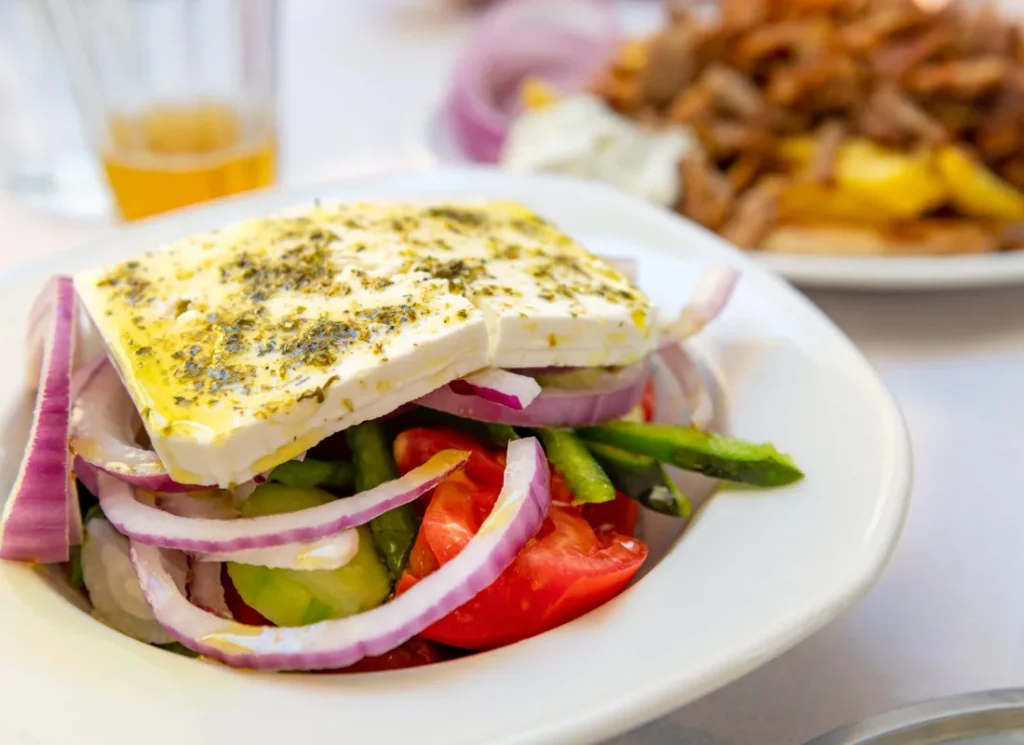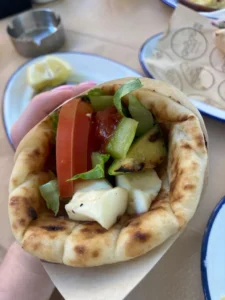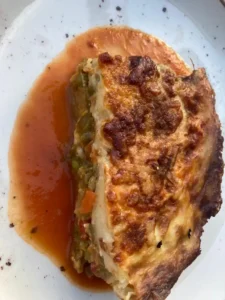This week on her food column, Zsófi is sharing everything you need to know about vegetarian Greek food after a recent trip to Athens, Greece. At the end, she tells you which vegetarian Greek dishes to look out for on the menu!

What I Ate in Greece as a Vegetarian
It’s 9.45 in the morning and I have just landed at Birmingham Airport. I spent the last week travelling in Greece with my family, gawking at the innocent-looking ancient rocks which, in reality, were the foundation upon which modern European civilisation as we know it had been built. Strolling calmly along seaside paths which, as we later found out, had been closed off to the public due to the danger of falling rocks. Rushing into the cold sea to escape the scorching summer heat. Drinking margaritas on our balcony till sunset while desperately trying to annihilate my very beloved family members at cards.
I am exhausted. Sleep-deprived. Dehydrated. Still covered in sweat and what I can only assume is ancient Greek dust. Bitter from having had to say goodbye to my family once again.
But my stomach… my stomach is satisfied. Content. Appeased. Full and yet already hungry. Craving not the 5 euro bagel and 3 euro bottle of water that I quickly managed to get a hold of right before boarding, but the wonderful medley of fresh vegetables, olive oil, pita bread, and spinachy pies that I had been consistently consuming since I set my foot on Greek land just a week prior.
One benefit to going on holiday with family (other than seeing them in real life of course), even offsetting the minor disagreements with my brother on whether the AC really needs to be turned on (it does, yes) or if he just has an inhumanely high tolerance to heat, and the eyerolls at my dad’s uhm… dad jokes, is that they won’t be satisfied with eating cheap supermarket pastry on the side of the road as a lunch, but will sit in restaurants and local eateries for at least one meal a day.
Now, as a vegetarian, I was slightly nervous about eating out, but it turned out, even though I am the only non-meat-eater in my family, I am certainly not the only one in Greece. While it was more difficult to find vegetarian and vegan options in the smaller towns by the seaside, Athens had plenty of greens to offer, and not just some stringy side dishes thrown together in a rather unsuccessful attempt to seem appetising.
More from Zsófi: How to Be Vegetarian in Hungary
What is Greek Food and Why is it Amazing
With a history dating back four thousand years, the Ancient Greek diet was built on the holy triad of olive oil, bread, and wine – and who could blame them? Greece’s Mediterranean climate provided and continues to provide today the ideal conditions for farming, its lands plotted with olive trees, orange and lemon trees, wheat fields, and aromatic vineyards.
While these ingredients continue to be the basis of Greek cooking, the historical path from Ancient to modern Greek cuisine is paved by run-ins with Europe’s largest conquering empires. The Romans, the Byzantines, and the Ottomans all took a turn at occupying the Greek lands and moulded their culinary traditions in the process.
It’s as a result of this history that Greek food shares so many similarities with that of its neighbouring countries. Just consider Pastitsio, a baked paste dish topped with beef ragu and béchamel sauce. Sound familiar? Yes, it is described by many as a Greek lasagna.
These similarities become even more apparent when we zoom in on Turkish and Greek cuisine thanks to the 400-year Ottoman Occupation of Greece that only ended in 1821. In fact, many Greek dishes have an identical twin in Turkey and vice versa, such as the Greek dolmadakia or Turkish dolma, a meze dish of vine leaves stuffed with rice and herbs.
Although culinary traditions have been lent and borrowed between Middle Eastern and Mediterranean nations all throughout history, the essential Greek ingredients have changed little. The cuisine remains to heavily rely on local farming and features fresh produce the like of courgettes, aubergines, and olives.
Other popular ingredients include dairy such as various types of cheeses and Greek yoghurt, or as they say in Greece, yoghurt. Furthermore, as you are never more than 90 kilometres at any point on Greek land from the sea has also led to the dominance of fish and seafood in Greek kitchens.
More from Zsófi: A Vegetarian’s Guide to London’s Chinatown
What to Order on a Greek Holiday as a Vegetarian
As the inexperienced baby vegetarian I was when I first stopped eating meat, I firmly believed that travelling from here on would be an ever-present dilemma between my dietary choices or having an authentic culinary experience. Now, six years later, I know this to be untrue. It is perfectly possible, and in fact, easy, to travel, try out the local delicacies and stand strong in my beliefs at the same time.
So if you’re a vegetarian worried about what it would mean for you to travel to Greece and whether you are doomed to eat just fries for the duration of your holiday, this article is for you. Below is a guide to what to eat on a herbivore Greek holiday.
Spanakopita
Spanakopita is one of Greece’s signature dishes. It is a beautifully flaky phyllo-based pastry that wraps around a cooked spinach, crumbled feta cheese, and kefalotyri cheese filling. It is flavoured according to taste, often with some lemon juice, dill, or other green herbs. It is the perfect snack for in between meals, or appetiser before a big lunch. It can also be consumed as a main course paired with some Greek salad or yoghurt.
Spanakopita first emerged during the Ottoman Occupation 400 years ago, and grew together with its Turkish twin, ispanaki. Originally, it was prepared in the mornings for field workers to carry in their pockets and eat while working. Having shed its humble beginnings, this spinach pie is now the most famous of all the Mediterranean nation’s wide selection of pastries, an absolute home staple.
Every traveller in Greece must try this delicacy. You can find it in any bakery or café, or, if you’re looking for a more elevated experience, many prestigious restaurants have adapted the recipe and are serving a more refined version of the classic spanakopita.
While spanakopita is by far the most well-known, there are many other pastries that are available for herbivore breakfasts. Hortopita is another example of a wonderfully healthy vegetarian option.
A phyllo pastry with a scrumptious filling of a variety of greens such as spinach, leek, or chard, usually accompanied by herbs, and crumbled cheese or egg, hortopita deservedly takes the second place for best Greek pie in our green-loving hearts.
Lastly, for all the cheese-superfans out there, the simple yet incredibly rich perek is worth a try. Its dough is made by mixing flour with water and salt, formed into thin layers and baked until crisp. Sandwiched between two layers of dough will be the feta cheese, eggs and any herbs that you wish for.
Souvlaki

Its origins rooted firmly in Ancient Greece, souvlaki is more than just the convenient fast food it seems at first sight. The first mention of this marinated meat dish that is grilled lined up on a skewer or a spit and enjoyed just as is or stuffed into pita bread with some fresh veggies was in none other than Homer’s Iliad where Achilles is preparing meat grilled on embers. Souvlaki further features in the writing of Aristotle and Aristophanes – I think it’s safe to say, souvlaki comes well recommended.
Now, I can already hear you protesting, Zsófi, we won’t be fooled by Ancient Greek philosophy! This is a meat dish! Yes. It is. It comes in countless forms, chicken, pork, doner meat, sausage… or halloumi, grilled mushrooms, and grilled vegetables.
While the original recipe necessitates some sort of meat, many restaurants, especially in central areas where tourists with crazy non-meat-eating ideas are expected to pop up, will now have plenty of options for vegetarians to enjoy this wonderful medley of flavours that is contained within the confines of the soft pita bread.
To recommend one out of the many establishments that can offer you this experience, my family and I dined at The Greco’s Project at Athens’s Mitropoleos. This turned out to be a great idea as the food was mouth-wateringly delicious, but it was also a bad idea as all I could think about for the rest of the trip were their incredible meze dishes and the grilled halloumi souvlaki that followed.
More from Zsófi: What to Eat in Spain as a Vegetarian
Moussaka

A dish popular in Greece, Turkey, the Middle East, and the rest of the Levant, moussaka can be best described as an aubergine casserole made with baked aubergines, a rich tomato beef ragu, potatoes, some béchamel sauce.
This dish originated as something similar to an eggplant stew in the 13th century in the Levant, and was introduced by Arab immigrants to Greece and Turkey. In the 1920, Nikolaus Tselementes, a well-known Greek chef developed the layered structure of the moussaka of today and added the béchamel topping.
Until this stage in its history, moussaka has had beef or pork mince in it as a staple ingredient. However, in more recent years, Vegetarian Moussaka has become more and more popular in Greece and around the globe. There are many versions of this dish, as some places opt to simply use Soya Mince instead of meat while other places prepare it with solely vegetables.
I can guarantee you with certainty that you will find Vegetarian Moussaka on the menu of the restaurants you choose to dine in in Athens and I can guarantee you as well that you will absolutely enjoy it. Personally, I tried a full vegetable one where to complement the eggplant, courgette and peppers were also invoked and included in the ragu. This version blew my mind away and I will absolutely try and recreate it at home (I’ll let you know how I do with that). If you want to find this one, I had it at the Antica Café and Restaurant situated at the beautiful spot right next to the Ancient Agora.
Soutzoukakia

While most places will have vegetarian versions of moussaka or souvlaki, there are many Greek dishes that sound mouth-wateringly delicious but feature meat to such an extent that a regular restaurant would not serve them in a meatless version. Luckily, Athens offered a surprisingly large selection of exclusively vegan restaurants.
These eateries, scattered all around the city centre, offered an opportunity to taste these “meaty” dishes that would be an absolute shame to miss. This is how I came to try soutzoukakia, a hearty dish of meatballs covered in aromatic tomato sauce and served with rice or fried potatoes.
Another dish with a history rooted in the Ottoman Empire, soutzoukakia originates from what is now the city of Izmir, Turkey. Its story is one of prosecution, and a lucky escape as it is Greek Ottoman Christians who first developed this recipe and upon fleeing Anatolia from oppression on the hands of the Ottomans, they carried it with them to the Greek lands.
This food is rich in both taste and history and is an absolute must try for all travellers in Greece. I first dipped my fork in it in a vegan restaurant called Veganaki. Here, they served these famous meatballs with a side of fried potatoes and tzatziki and let me tell you, it was wonderful.
Mezze Dishes

I have mentioned the word mezze many times now in this article but have not yet offered an explanation. Mezze are a selection of dishes, hot or cold, that are served as hors d’oeuvres in Greek, Turkish and Middle Eastern traditions. They are typically smaller portions that are shared between all at the dining table. They are also the saving grace of every vegetarian.
Many mezze dishes are naturally meat free and can be found at – and I can’t emphasise this enough – EVERY Greek restaurant that you set your foot in. These dishes are an integral part of Greek culture and will most likely be the favourite part of your meal. Some examples from my trip included:
Dolmadakia or vine leaves
These vine leaves stuffed with rice and aromatic herbs, and further flavoured by lemon juice and olive oil, are my absolute favourites.
Fava bean dip
Contrary to what you might very rightly assume, th Greek fava bean dip is not made from fava beans, but yellow split beans that are pureed and served as a dip with fresh pita bread. It is lemony. It is garlicky. It is (in my opinion) hummus’s better older brother.
Tzatziki
Another dip usually served with pita bread, tzatziki is the world-famous mix of yoghurt, cucumbers, garlic, and dill. Refreshing in the heat and absolutely delicious.
Saganaki
This one is for the cheese lovers. Saganaki is a block of cheese, pan fried. Simple, and yet the secret hides in the quality of the ingredients. The cheese is chewy enough for it to feel like a substantial appetiser and soft enough to tear apart and share between all.

Great article!! I needed some ideas also.
Hi Eve, I’m glad you enjoyed it! Let us know if you end up trying any of these dishes, would love to hear your opinions!